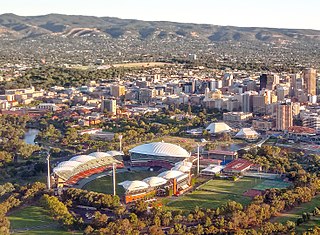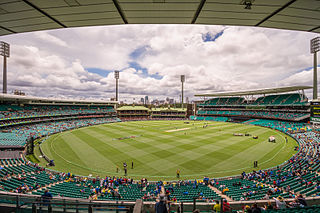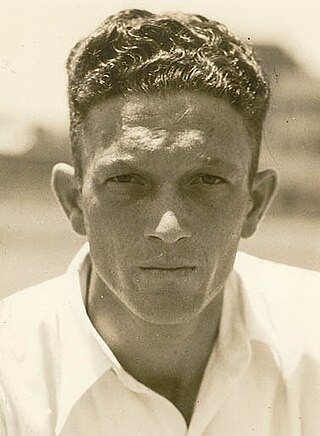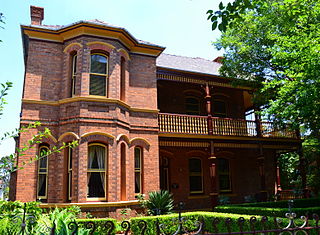
Sir Donald George Bradman, nicknamed "The Don", was an Australian international cricketer, widely acknowledged as the greatest batsman of all time. His cricketing successes have been claimed by Shane Warne, among others, to make Bradman the "greatest sportsperson" in history. Bradman's career Test batting average of 99.94 is considered by some to be the greatest achievement by any sportsman in any major sport.

William Joseph O'Reilly was an Australian cricketer, rated as one of the greatest bowlers in the history of the game. Following his retirement from playing, he became a well-respected cricket writer and broadcaster.

The Adelaide Oval is a sports ground in Adelaide, South Australia, located in the parklands between the city centre and North Adelaide. The venue is predominantly used for cricket and Australian rules football, but has also played host to rugby league, rugby union, soccer, tennis among other sports as well as regularly being used to hold concerts. Austadiums.com described Adelaide Oval as being "one of the most picturesque Test cricket grounds in Australia, if not the world." After the completion of the ground's most recent redevelopment in 2014, sports journalist Gerard Whateley described the venue as being "the most perfect piece of modern architecture because it's a thoroughly contemporary stadium with all the character that it's had in the past."

The Southern Highlands, also locally referred to as the Highlands, is a geographical region and district in New South Wales, Australia and is 110 km south-west of Sydney. The region comprises the local government area of the Wingecarribee Shire and also towns of the Mulwaree Shire. The region is also considered a wine region.

The Sydney Cricket Ground (SCG) is a sports stadium in the Moore Park suburb of Sydney, New South Wales, Australia. It is used for Test, One Day International and Twenty20 cricket, as well as, Australian rules football and occasionally for rugby league, rugby union and association football. It is the home ground for the New South Wales Blues cricket team, the Sydney Sixers of the Big Bash League and the Sydney Swans of the Australian Football League. It is owned and operated by Venues NSW, an agency of the Government of New South Wales who also hold responsibility for Stadium Australia and the Sydney Football Stadium.

Moore Park is a suburb in the Eastern Suburbs of Sydney located 3 kilometres (1.9 mi) from the CBD, in the state of New South Wales, Australia. It is part of local government area of the City of Sydney.

The South Australia men's cricket team is an Australian men's professional first-class cricket team based in Adelaide, South Australia. South Australia play their home matches at Adelaide Oval and Karen Rolton Oval, they are the state cricket team for South Australia representing the state in the Sheffield Shield competition and the limited overs Marsh One-Day Cup. The team is selected and supported by the South Australian Cricket Association (SACA). Their Marsh One-Day Cup uniform features a red body with black sleeves. They were known as the West End Redbacks between 1996 and 2024 due to a sponsorship agreement with West End. The Redbacks formerly competed in the now-defunct KFC Twenty20 Big Bash, but were succeeded by the Adelaide Strikers in 2011 because this league was replaced with the Big Bash League.

Cootamundra, nicknamed Coota, is a town in the South West Slopes region of New South Wales, Australia and within the Riverina. It is within the Cootamundra-Gundagai Regional Council. At the 2016 Census, Cootamundra had a population of 6,782. It is located on the Olympic Highway at the point where it crosses the Muttama Creek, between Junee and Cowra. Its railway station is on the Main Southern line, part of the Melbourne-to-Sydney line.

North Sydney Oval is a multi-use sporting facility in North Sydney, New South Wales, Australia, owned and operated by North Sydney Council. First used as a cricket ground in 1867, it is also used for Australian rules football, rugby league, rugby union and soccer.

Bowral is the largest town in the Southern Highlands of New South Wales, Australia, about ninety minutes southwest of Sydney. It is the main business and entertainment precinct of the Wingecarribee Shire and Highlands.

Alan Falconer Kippax was a cricketer for New South Wales (NSW) and Australia. Regarded as one of the great stylists of Australian cricket during the era between the two World Wars, Kippax overcame a late start to Test cricket to become a regular in the Australian team between the 1928–29 and 1932–33 seasons. A middle-order batsman, he toured England twice, and at domestic level was a prolific scorer and a highly considered leader of NSW for eight years. To an extent, his Test figures did not correspond with his great success for NSW and he is best remembered for a performance in domestic cricket—a world record last wicket partnership, set during a Sheffield Shield match in 1928–29. His career was curtailed by the controversial Bodyline tactics employed by England on their 1932–33 tour of Australia; Kippax wrote a book denouncing the tactics after the series concluded.

Donald Tallon was an Australian cricketer who played 21 Test matches as a wicket-keeper between 1946 and 1953. He was widely regarded by his contemporaries as Australia's finest ever wicket-keeper and one of the best in Test history, with an understated style, an ability to anticipate the flight, length and spin of the ball and an efficient stumping technique. Tallon toured England as part of Don Bradman's Invincibles of 1948 and was recognised as one of the Wisden Cricketers of the Year in 1949 for his performances during that season. During his Test career, Tallon made 58 dismissals comprising 50 catches and 8 stumpings.

The Prime Minister's XI or PM's XI is an invitational cricket team picked by the Prime Minister of Australia for an annual match held at the Manuka Oval in Canberra against an overseas touring team. The Australian team usually consists of up-and-coming grade cricketers from the Canberra region and state players.
Robert Michael Radford AM was an Australian cricket administrator.

The appearances of former Australian cricketer Don Bradman in popular culture are many and varied. As a player, he first came to prominence during the 1928/29 season. His record-breaking performances on the 1930 tour of England made him a national hero in Australia. Bradman was a private person who did not enjoy the adulation associated with his fame. In cricket, a batsman who enjoys an exceptional run of form over an extended period is sometimes called Bradmanesque.
This article describes the history of Australian cricket from the 1918–19 season until 1930.

Victor Thomas Trumper was an Australian cricketer known as the most stylish and versatile batsman of the Golden Age of cricket, capable of playing match-winning innings on wet wickets his contemporaries found unplayable. English cricket captain Archie MacLaren said of him, "Compared to Victor I was a cab-horse to a Derby winner". Trumper was also a key figure in the foundation of rugby league in Australia. His photograph taken by George Beldam in 1905 is often considered to be the greatest cricketing photograph ever taken.

The Bradman Museum & International Cricket Hall of Fame is a permanent cultural exhibition dedicated to the game of cricket and Australian cricketing hero Sir Donald Bradman. The Museum located in the Australian town of Bowral, New South Wales. The exhibition opened in November 2010 in buildings formerly used by the Bradman Museum, which was devoted to the cricketing career of the Australian batsman Sir Donald Bradman. The Bradman Museum opened in 1989. The Hall of Fame incorporated all of the former Bradman Museum's holdings. The Bradman Museum was, and in effect remains, the only museum in Australia dedicated principally to an individual.

St Leonards Park is a heritage-listed bowling club, 15-hectare (37-acre) urban park, rugby field and cricket oval at 283a Miller Street, North Sydney, North Sydney Council, New South Wales, Australia. It was designed by William Tunks, Mayor and built during 1838. It was added to the New South Wales State Heritage Register on 31 July 2015.

Monteith is a heritage-listed residence at located 266 Glebe Point Road in the inner western Sydney suburb of Glebe in the City of Sydney local government area of New South Wales, Australia. It was built in 1890. It was added to the New South Wales State Heritage Register on 2 April 1999.





















